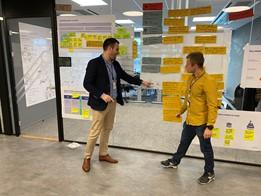Transcript - Peak Consulting Group
[00:00:05] For the past 14 years or so, we've been very involved on how to optimize optimized execution of strategic projects, meaning faster, better, more predictability. Which is why we followed Half Double over the past recent years and for the past two years, we've been involved in other projects myself, ourselves. I would like to show you two things. First of all, talk a little bit about why we ventured into trouble. And secondly, some thought about half double implementation. I am talking about half double, if you look at the marketplace today, both public and private sector, there is a gap because on one side you have the traditional approach, organizations who invested heavily in product management, training, doing training, just as we had before, like the quarter, for example, adding more training on top with business change management project leadership. On the other side, you have people who ventured fully into the agile domain, gone all in, and that leaves a gap. And we think that this gap is filled or can be taken by half double because you basically take the best of both worlds. The good thing, though, is also you could see half as a stepping stone for a company who wants to venture in maybe fully into agile over time. But is half of it then a silver bullet? Absolutely not. It still requires protocol organizations and project managers to invest in building the necessary skills, skills like product breakdown, estimation and planning. When we talk about implementation. There are some pitfalls that you need to steer clear of, and I've chosen a couple here today, six to be exact, to discuss with you. First of all, when you are to implement a framework like Hoft, it's all about tailoring. Of course, there are some principles, but you don't you don't have to be rigid about it.
[00:02:09] You need to be flexible to get it to work for your organization. So let's take an example. Colocation. Colocation is great, getting all the resources at one place in one room. But in some instances it makes sense to go in a separate room and just sit producing. And other times you seem out there to do field analysis. So tailor it to fit your organization, your needs, your culture. Motivation, culture. What does that mean? Well. I'm an engineer in telecommunications, so I've been sending a lot of situations, and when you start to apply principles such as big room planning, that can be a very overwhelming exercise for introverts, for instance. So you need to make sure how you actually stop your chattering into the culture. Thirdly, finding the right pace in your projects, what I mean is if you take your projects and your milestones and you pay them too close to each other, you don't have time to produce. If you put them too far apart, there's a risk of slack. Supporting your stakeholders now and later on is the right way to gain support of a long time, but you also need to be very clear about what their needs are. So what you do fits with what they need. An example, if you take, for instance, portfolio management, if half of your project organization reports in a traditional manner using project status reporting, using putting in data in your project systems and the other parts have a brown paper with Post-it notes, it can be quite difficult for traditional executive management to do portfolio management because in some areas it can be pares and apples. So make sure you understand what kind of information they need in order to make intelligent decision making.
[00:04:15] In all.
[00:04:17] Industries, I would say there are there are rules, there are systemic approaches on how you should work, there are requirements you are working regulate its environments. So make sure you don't lose your license to operate an example in the public sector. If you work on large scale I.T. projects, you should submit your project documentation to watch the Ministry of Finance. Now, if you take a photo of your wall and send that off to the Ministry of Finance, I can tell you one thing, you're going to end on top of that shitlist. You don't want to be that. So you have to make sure how to actually adopt that into the real world.
[00:04:58] And lastly.
[00:05:00] It requires bold decision making in order to succeed. Again, an example, if you want to succeed with this, this also means cutting down the number of projects you run in order to more efficiently utilize your resources. This is not a simple thing. This is a change. So all and implementing half is about bold decisions. It's about tailoring and and it's about implementation.
[00:05:28] Talking about implementation. Just think about this for two seconds, what's the most crucial thing to get right in all of this? Succeed with project?
[00:05:39] Some of you are probably thinking, well, requires me to have the best resources in the most efficient amount of time and clear goals and clear ownership, and you're all right. But these are also the fundamental elements of how feasible. And the reason I'm saying this is that if you base your implementation alone on a pilot, which is set up for success, guess what? You're going to have success. But the risk is you create a cult regarding surrounding this pilot, and this makes the transformation into the whole organization more difficult. So just be aware of that. These are the things we've been working about. So how do we actually implement it fully into an organization? Understand the systemic cultures.
[00:06:27] Like any transformation, it all begins and ends with people.
[00:06:35] Now, organizational calibration, just like I said before, they are structures already this organization, so make sure you understand what the skill level of the maturity level, what regularly, what industry regulations are there to adhere to? What governance is there to be supported?
[00:06:53] Secondly, when on boarding orchestrated, think about the orchestration of the whole implementation up front, yes, the pilot, if you use that, is a part of the orchestration. But think back from the get go. Motivation is a big driver for this, but you also need to understand what are the barriers for success so you can actually think that into your planning and your onboarding the most important thing. For successful implementation, in my opinion, is that once you get the value out of it and to it's sustainable and with a sustainable I mean, it works also. Six months after your consultants left, also 12 and 24 months.
[00:07:40] I just want to leave you with a couple of words with one of my colleagues, and it just go back and re re emphasize that this is all about people. You're going to change the behavior, the whole mindset of an organization, and also to remind you that change changes in emotion.
[00:07:59] It's not a list.
[00:08:01] So if you want to hear more about calibration, organisational calibration, we have a cafe set up.
[00:08:07] Thank you for your time.
[00:08:13] Thank you, Patrick. A few questions, too. Do you think that now that you've shown the implementation model here, do you think that it would be even possible to do in a successful implementation of half double without external help from consultants?
[00:08:30] It's a good question, I'm I'm sure that organization can lead themselves, but I think that those of us who done it a lot might have some tips on how to stay away from the pitfalls. So I think organization can gain benefit from using external help.
[00:08:47] Ok, so if they wanted to do them, do it all by themselves. What would be the first step that you would recommend them to do?
[00:08:55] I would recommend them to get into a community of practice so they can share experience with what people like you guys about what works, what doesn't work. Why didn't it work?
[00:09:08] And and now that you're here, I would like to draw a little upon your experiences as a consultant for many years. So so let's play with the idea that you're helping half the institute to succeed in the best possible way. What would be your best advice to the institute if we want to spread this concept or diffuse this concept to the world successfully? What would be your best advice to the institute?
[00:09:33] I think chartering is the key word here and tailoring into the country specific country that's really actually dealing with it, because if you take all the best practices in the project domain PMI, you can actually see that it's suited for the American market. Prince to you could see that originates from from the U.K. If you take IBM, you can actually see there's a local tailoring for each country. So I think being aware and building local communities of practice around each country I think would be a benefit.
[00:10:02] Thank you so much, Patrick.

